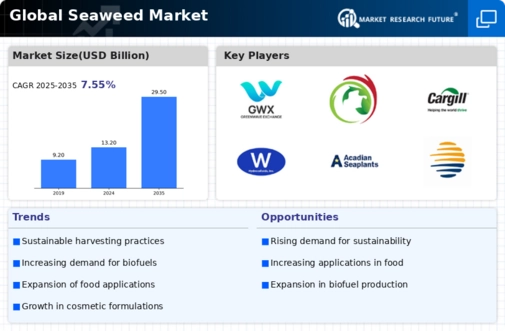Top Industry Leaders in the Seaweed Market

Strategies Adopted by Seaweed Key Players
The Seaweed market is experiencing significant growth driven by increasing consumer awareness of the nutritional benefits and sustainable nature of seaweed-based products. This analysis provides insights into the key players, strategies adopted, market share dynamics, emerging companies, industry trends, current investments, the overall competitive scenario, and a notable development in 2023.
Key Players:
- Kimica Alginates (Japan)
- Arthur Branwell & Co., Ltd. (UK)
- Polygal Ag (Switzerland)
- Snap Alginates (India)
- Ingredients Solutions, Inc. (US)
- L. Thomas and Co., Inc. (US)
- Cargill Foods (US)
The Seaweed market revolve around sustainable sourcing, product diversification, technological advancements, and global market expansion. Sustainability is a key focus, with companies investing in eco-friendly cultivation methods, such as integrated multi-trophic aquaculture (IMTA) and land-based seaweed farming. This ensures a minimal environmental impact and aligns with consumer preferences for sustainable products.
Product diversification is another strategy to cater to a broad range of consumer needs. Seaweed is incorporated into various products, including snacks, supplements, and cosmetics. Key players continually innovate to introduce new seaweed-based products, capitalizing on the versatility of seaweed as a functional ingredient.
Technological advancements play a crucial role in optimizing seaweed cultivation and processing. Companies invest in research and development to enhance cultivation techniques, increase yields, and improve the extraction of valuable compounds from seaweed. This focus on innovation allows key players to maintain a competitive edge in the market.
Global market expansion is essential for established players looking to tap into the growing demand for seaweed products worldwide. Strategic partnerships, acquisitions, and distribution agreements contribute to the global reach of seaweed-based products.
Market Share Analysis:
Market share dynamics in the Seaweed market are influenced by factors such as the quality and reliability of the seaweed supply chain, brand recognition, and the ability to offer a diverse range of seaweed-based products. Companies that establish robust relationships with seaweed farmers or cultivators ensure a consistent and high-quality supply of raw materials.
Brand recognition is pivotal in a market where consumer trust is closely tied to perceptions of seaweed quality and sustainability. Companies that invest in transparent labeling, certifications, and communicate their sustainable practices effectively tend to build stronger brand loyalty.
Diverse product offerings contribute to market share as consumers seek varied ways to incorporate seaweed into their diets. Companies that can offer seaweed snacks, seasonings, extracts, and other innovative products are well-positioned to capture a larger share of the market.
News & Emerging Companies:
News in the Seaweed market often revolves around advancements in cultivation techniques, new product launches, and collaborations between companies and research institutions. Emerging companies frequently focus on niche seaweed varieties, innovative processing methods, and unique applications for seaweed-based products.
Industry news also highlights partnerships between seaweed companies and food manufacturers, illustrating the increasing integration of seaweed into mainstream food products. Additionally, collaborations with restaurants and chefs contribute to the emergence of seaweed as a culinary ingredient.
Industry Trends:
Investment trends in the Seaweed market highlight a commitment to research and development, sustainable practices, and market education. Companies invest in R&D to discover novel applications for seaweed, improve cultivation efficiency, and extract valuable bioactive compounds with potential health benefits.
Sustainable practices extend beyond cultivation to packaging and processing. Companies are increasingly adopting eco-friendly packaging materials and exploring energy-efficient processing methods to minimize their environmental footprint.
Market education remains a key investment trend as companies aim to raise awareness about the nutritional benefits and culinary versatility of seaweed. This includes collaborations with nutritionists, chefs, and social media influencers to promote seaweed as a healthy and flavorful ingredient.
Competitive Scenario:
The Seaweed market presents a dynamic and competitive landscape where companies strive to balance innovation, sustainability, and consumer education. Established players leverage their expertise and global presence, while emerging companies contribute to the market's dynamism with novel products and cultivation techniques.
The adaptability of seaweed to various culinary applications, coupled with its rich nutritional profile, positions it as a versatile and sought-after ingredient. Companies that can successfully navigate the complexities of sustainable cultivation, product innovation, and global market dynamics are poised for long-term success.
Recent Development
A notable development in 2023 within the Seaweed market was the increased focus on personalized nutrition. Key players introduced seaweed-based products tailored to specific dietary preferences and health goals. This development aligns with the broader trend in the food industry towards customization, allowing consumers to choose seaweed products that align with their individual nutritional needs and lifestyle choices.


